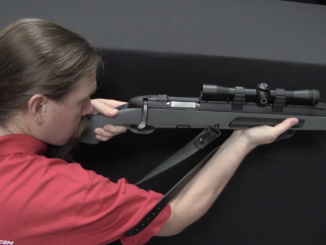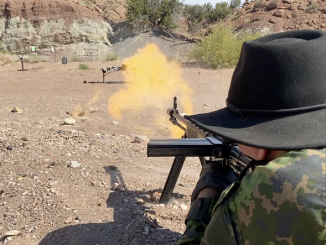Companion shooting video on InRangeTV:
https://youtu.be/a91nJOD31Lk
We have a new Brownells BRN-10A reproduction AR-10 to take a look at today, hot off the production line! Brownells is making both AR-15 and AR-10 rifles in their “Retro” reproduction line, but this is definitely the more interesting one to me. You can piece together a good retro AR-15, but the AR-10 platform has until now been very limited in retro options.
In today’s video, I am comparing the BRN-10A to a semiauto conversion of an original Portuguese AR-10. This allows some good comparisons, but it is also of limited use, because Brownells has chosen to reproduce the cleaner lines of the early Cuban-pattern AR-10. Details like the muzzle, handguards, charging handle, and front sight block are quite different between early and late original AR-10s, but the comparison with a late Portuguese one does allow us to see how much detail did go into properly replicating many of the other elements.
Overall, I am quite impressed by Brownells’ new rifle. There is room for improvement, and my biggest complaint is the feel of the handguards – but they certainly do look right. Incidentally, after I finished filming I spoke with the company, and was told that a more accurate pistol grip is in development, as are waffle-pattern mags. Those will be nice improvements added to guns as they start shipping. The BRN-10 is definitely a much better reproduction than the old Armalite AR-10B rifles, and a heck of a lot less expensive than finding a semiauto conversion of an original one!
Related videos:
Semiauto Original Portuguese AR10: https://youtu.be/7hibrCMBq_8
Armalite AR-10B Reproduction: https://youtu.be/OJcuBB24yoE
Shooting a Sudanese AR10: https://youtu.be/nuEKwdwoqBA




Speaking of good furniture, does anyone want the gun to get a traditional varnished (or traditional Japanese lacquered) wood stock? I know you’re not jumping into jungle but still…
You could start with these: http://www.blackgunswood.com
Thanks for the link!
Well, the military in Myanmar is following that route to keep Vietnam War vintage M16A1’s going:
http://myccwnews.com/improvised-m16a1-wooden-handguards-in-myanmar/
Back in the mid 1960’s, Matel toy company came out with a toy gun patterned after the AR10, it had a detacthable mag, and shot the who “bullet” out. that would be a nice companion to this gun as a “show gun?” (also very hard to find I would imagine, as they were well used by the boys who got one!!)
That muzzle resembles the Finnish RK-family and I suppose it was intended to be used as yhe RK-62, ie cutting wire. Which one did inspire the other one ?
I like this weapon (meaning original incl. this replica) great deal more than small bore AR15. This is what U.S. Army was supposed to adopt into inventory and they would be happy till this day. Of course to be clear, we talk semi-auto version only; select-fire could be accomplished with heavy barrel and bipod equipped version.
If any modernisation could be done to it is to change caliber to 6.5 Creedmore or 6.5mm U.S and you have rifle for another 50 years.
A pertinent video here – MAC is shooting the same rifle, side by side with early AR15 (from time when it became Colt’s mainstay).
https://www.youtube.com/watch?v=zFCvkJhROMA
I think this provides comparison in many ways. Yes, AR10 kicks more, but it delivers.
“6.5mm U.S”
What is that cartridge? I never heard about cartridge with that designation.
“This is what U.S. Army was supposed to adopt into inventory and they would be happy till this day.”
No, they would have to adopt intermediate cartridge anyway.
“select-fire could be accomplished with heavy barrel and bipod equipped version.”
Apparently they find that it should be done that way, when they adopted M14 rifle together with M15 rifle (heavier barrel):
http://modernfirearms.net/en/assault-rifles/u-s-a-assault-rifles/m14-eng/
but for some reason never started production of M15.
The 6.5mm U.S. is/was a hypothetical cartridge which I picked in one o articles. At the moment I cannot find a reference to it.
We can discuss to considerable length what make “intermediate cartridge”. In my way of understanding, the 7.62×51 Nato is the one already (evidently so when compared with 30.06). In my perception (and I share it with many others), the 5.56×45 Nato is a small-bore cartridge. In fact, CZ factory source I was one time in touch with, call it “mikro-raze” (micro-caliber).
7.62 NATO is a full power rifle cartridge. Essentially it is a modernized .30-06. Modernization with 1950s powder technology allowed to cut down the size and weight a little, but the ballistics are essentially the same as US military issue .30-06. Nobody would seriously call the 7.62 NATO an intermediate cartridge today, although at the time of adoption it was sometimes suggested to be one for political reasons.
5.56 NATO is a small bore intermediate cartridge. It is still considerably more powerful than any classic defensive pistol cartridge ( i.e. excluding handgun hunting cartridges). Its long range ballistics, even from 14.5 inch carbine barrel, are superior to classic intermediate cartridges such as 7.92×33mm and 7.62×39mm. I am not very well informed on the ballistics of the Czech 7.62×45mm, apart from it having a somewhat higher MV than 7.62×39mm.
“7.62×51 Nato is the one already (evidently so when compared with 30.06)”
No, even if it is shorter than 7,62×63 it is not intermediate in terms of function. Intermediate name imply that cartridge should be between bigger (full-power) and smaller (sub-machine gun) cartridges, but is also supposed to supplement these both, not make first one extinct.
“CZ factory source I was one time in touch with, call it “mikro-raze” (micro-caliber).”
Perception depending on background, .30-40 Army was also small caliber when introduced, when compared to then default .45-70.
“5.56×45 Nato is a small-bore cartridge”
If you allow anachronism, it could be called low-impulse cartridge (that term was probably unknown to designer of that cartridges), thus made to be used in full-auto weapons, light but yet which could be kept under control.
Commencement of implementation of M16 and associated ammunition led to considerable pains, as we all know. The tail of long development has produced M4A1 which was found infective in ranges over 300m. This has led to current ongoing (and very costly) search for replacement, in form of both, weapon and caliber.
IF M14 was replaced early in 1960 straight with AR10 (with benefits of better hit probability and lower weight), lots of this struggle and expense was saved. There are plenty of cases worldwide to document the trend of moving back to 7.62×51 for standard issue rifle.
“M16”
I am not sure about more development, but keep in mind that according http://modernfirearms.net/en/assault-rifles/u-s-a-assault-rifles/m16-m16a1-m16a2-m16a3-eng/
[In 1964] US Air Forces officially adopted new rifle as M16. Same year US Army adopted the XM16E1 as a limited standard rifle, to fill the niche between discontinued 7.62mm M14 rifle and the forthcoming SPIW system.
Therefore M16 was then considered as stop gap solution to be forgotten as fast as SPIW would be adopted.
The difference between a 20″ and 14.5″ barrels in terms of bullet velocity with 5.56 NATO is about 50 meters at long ranges. In other words, the bullet velocity out of a 14.5″ barrel at 450 meters is about the same as at 500 meters from a 20″ barrel. That is not a very big difference.
The 5.56×45mm cartridge was designed to be effective up to 600 meters from a 20″ barrel. Some consider that to be very optimistic for various reasons, but mostly terminal effect. However, these people do not understand that in military sense immediate terminal effect at such ranges is less relevant than at shorter ranges. A soldier that is hit is much less likely to be effective at such ranges, despite ostensibly he might seem to continue fighting. He is unlikely to participate in any offensive action and will probably require serious medical attention sooner or later. In a wider military context that is significant.
It continues to amaze me how little could have been done to remedy most of problems with current 5.56×45. One such possibility is 6×45
https://en.wikipedia.org/wiki/6%C3%9745mm
Also, the Sako originated 6PPC (case based on M43) is a phenomenal little cartridge. Just couple days ago on range day with friend of mine we verified what we already knew – it can produce sub MOA accuracy out to 300 yards over and over again and recoil is negligible.
“accuracy out to 300 yards over and over again”
I must one of original requirements for new cartridge, which will become 5,56×45 NATO was according to https://en.wikipedia.org/wiki/5.56%C3%9745mm_NATO
Bullet exceeding supersonic speed at 500 yards
With then available technology it was calculated that needed muzzle velocity (for 55 gr bullet) is 3300 fps (around 1000 m/s). You might ask why it is important?
Well, accuracy is significantly hindered (or to be more precise spread is increased) when bullets goes from supersonic to subsonic during flight, than you might except from linear extrapolation from data for pure supersonic flight.